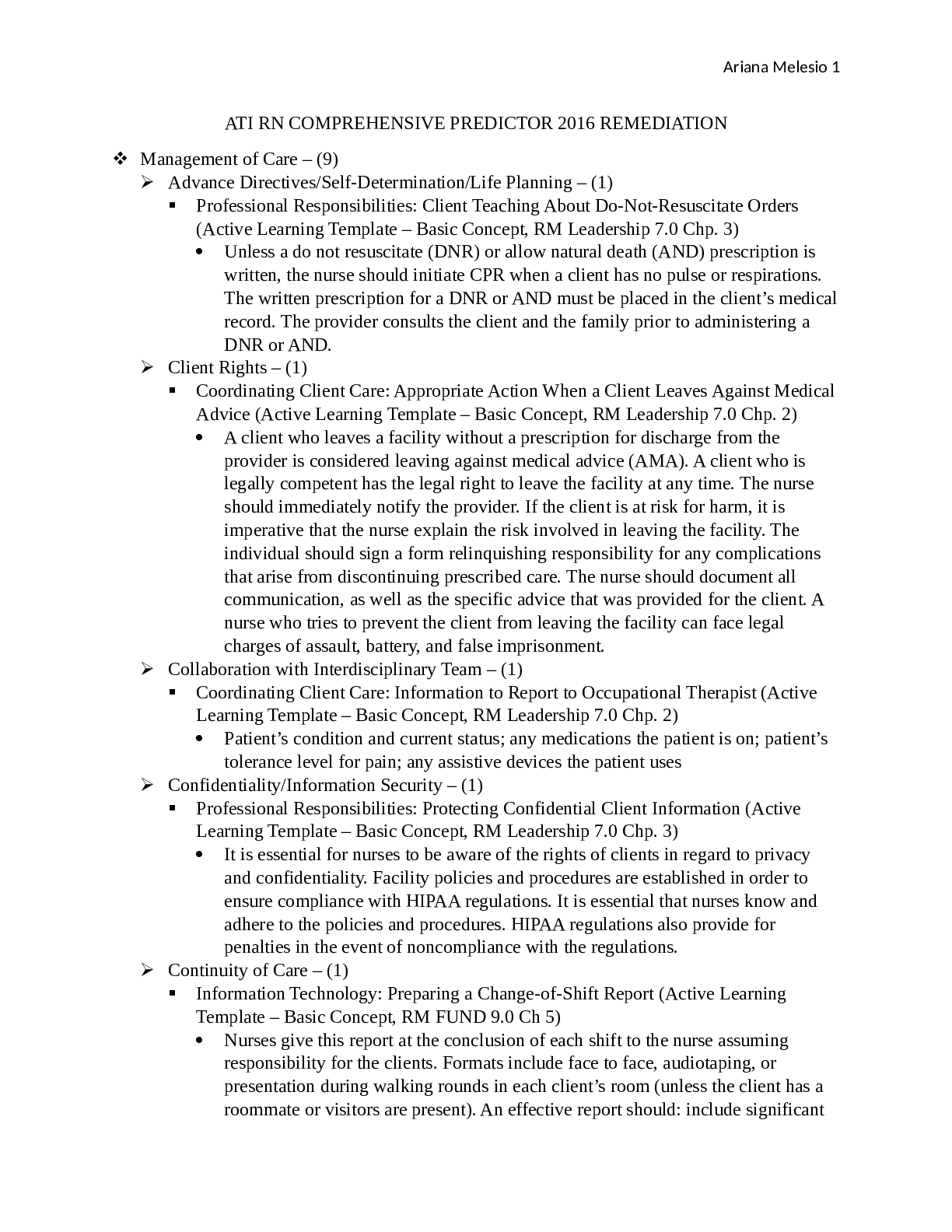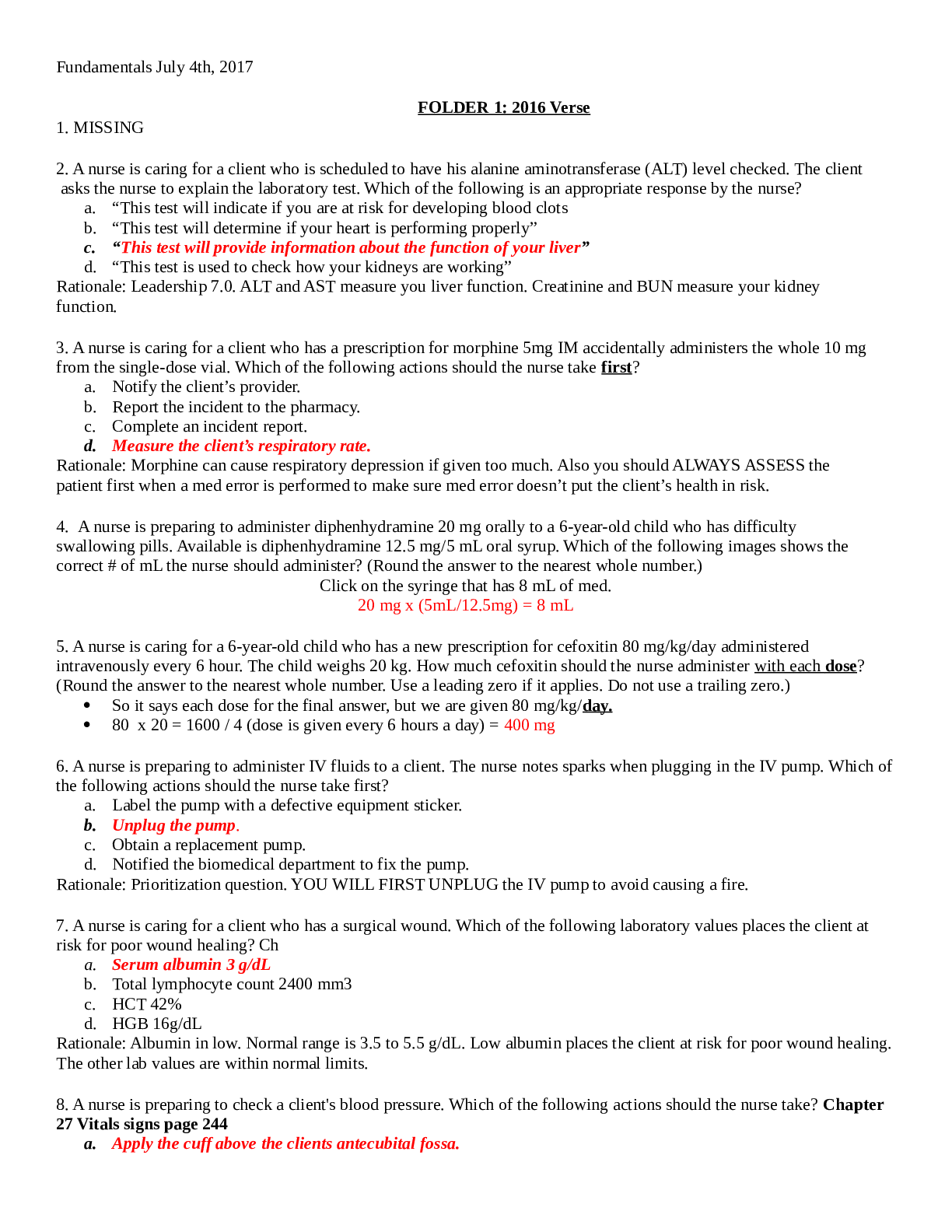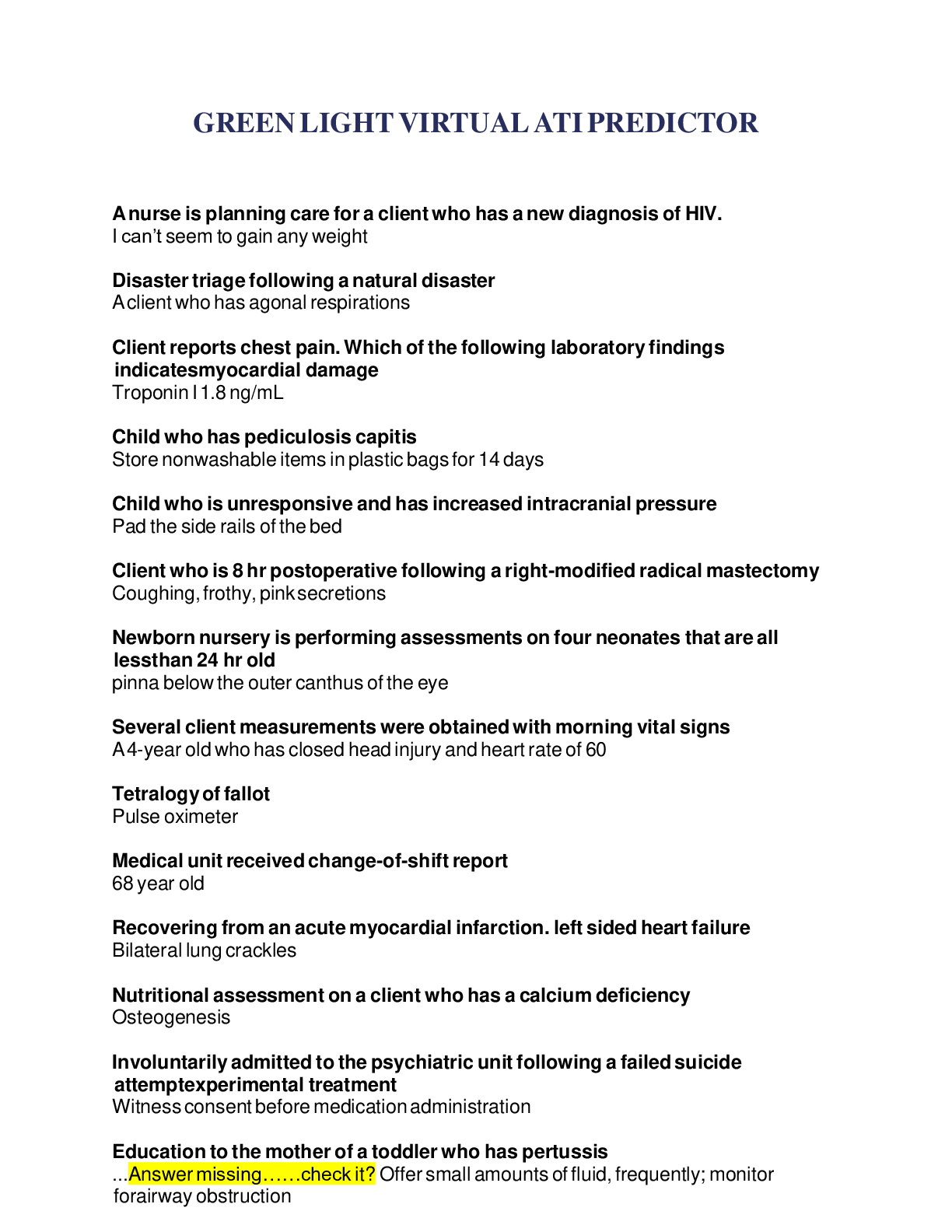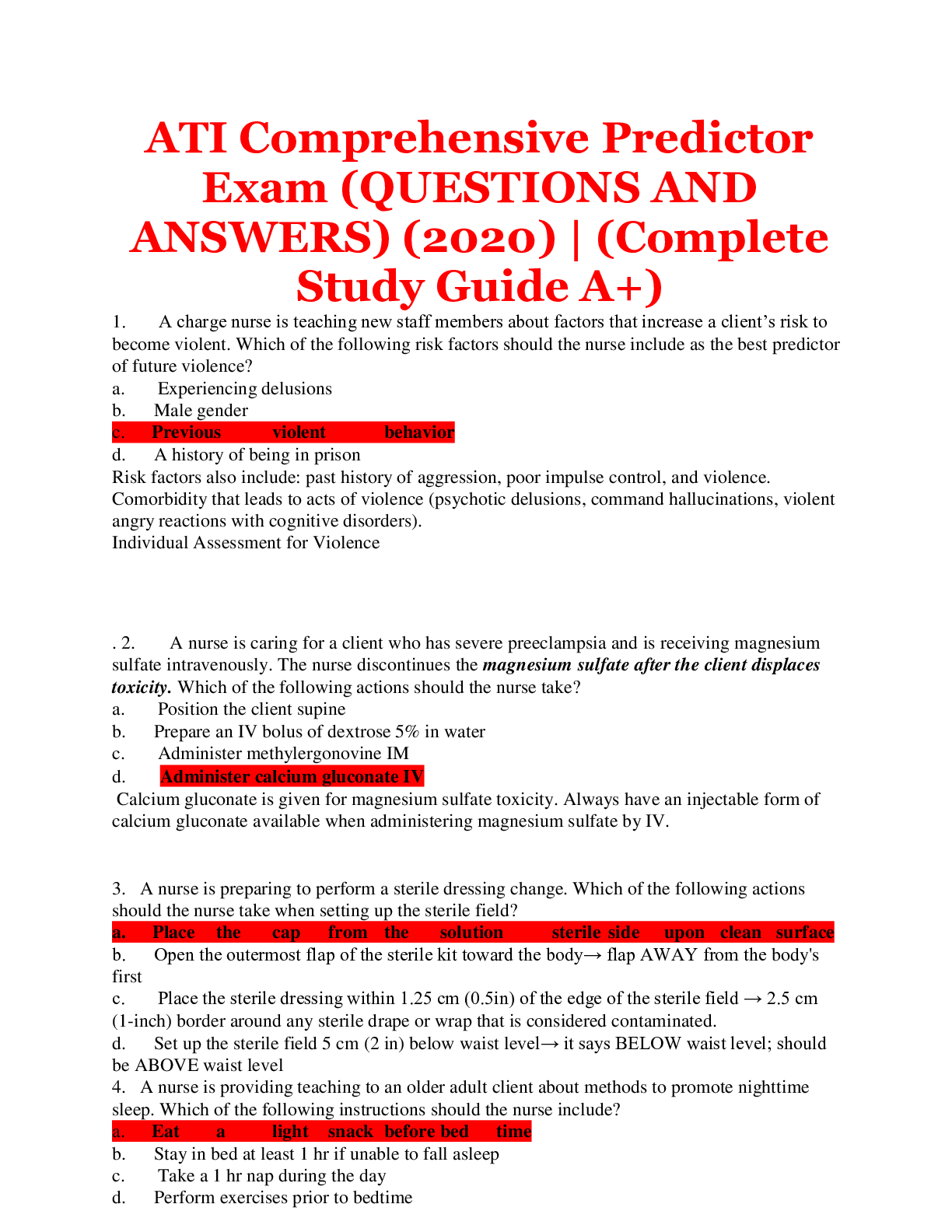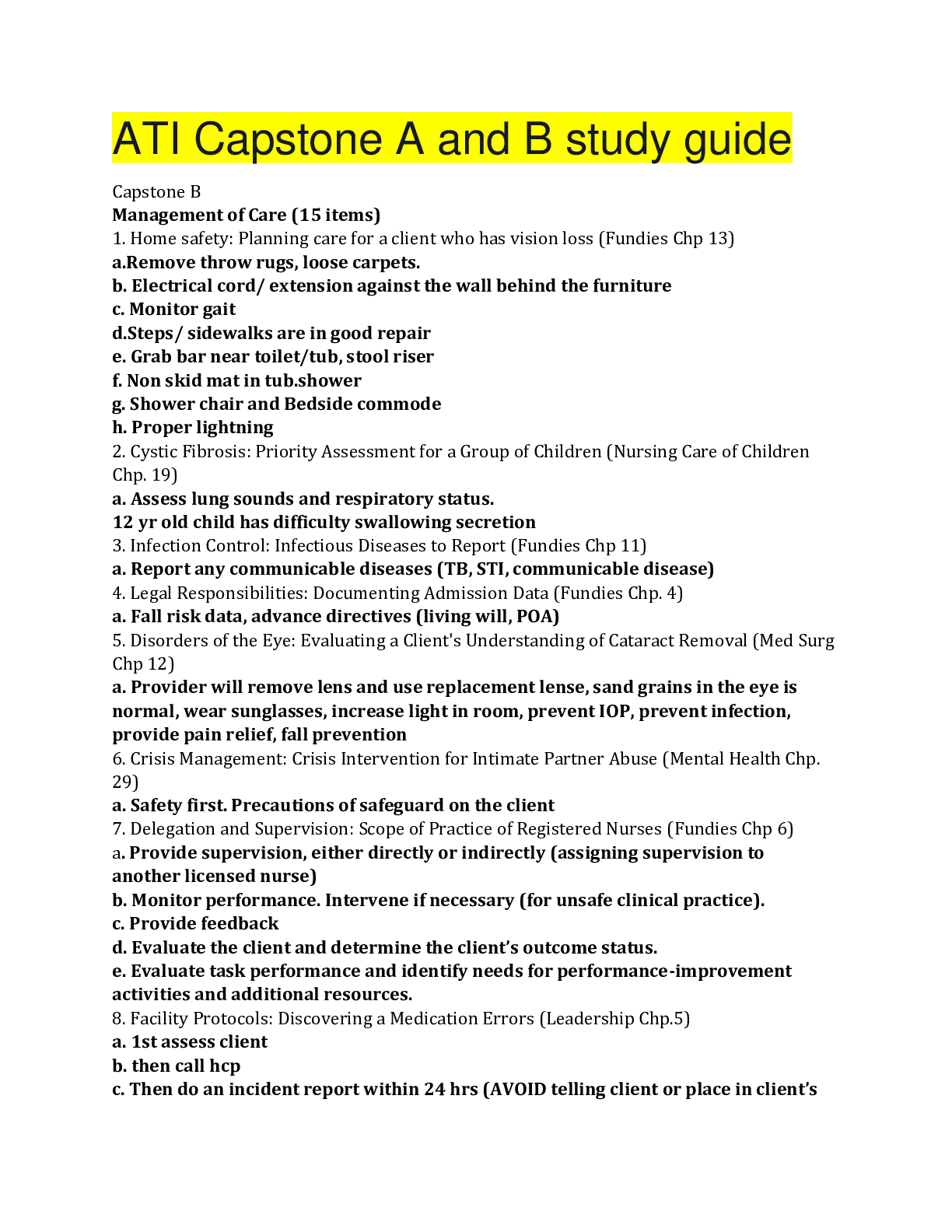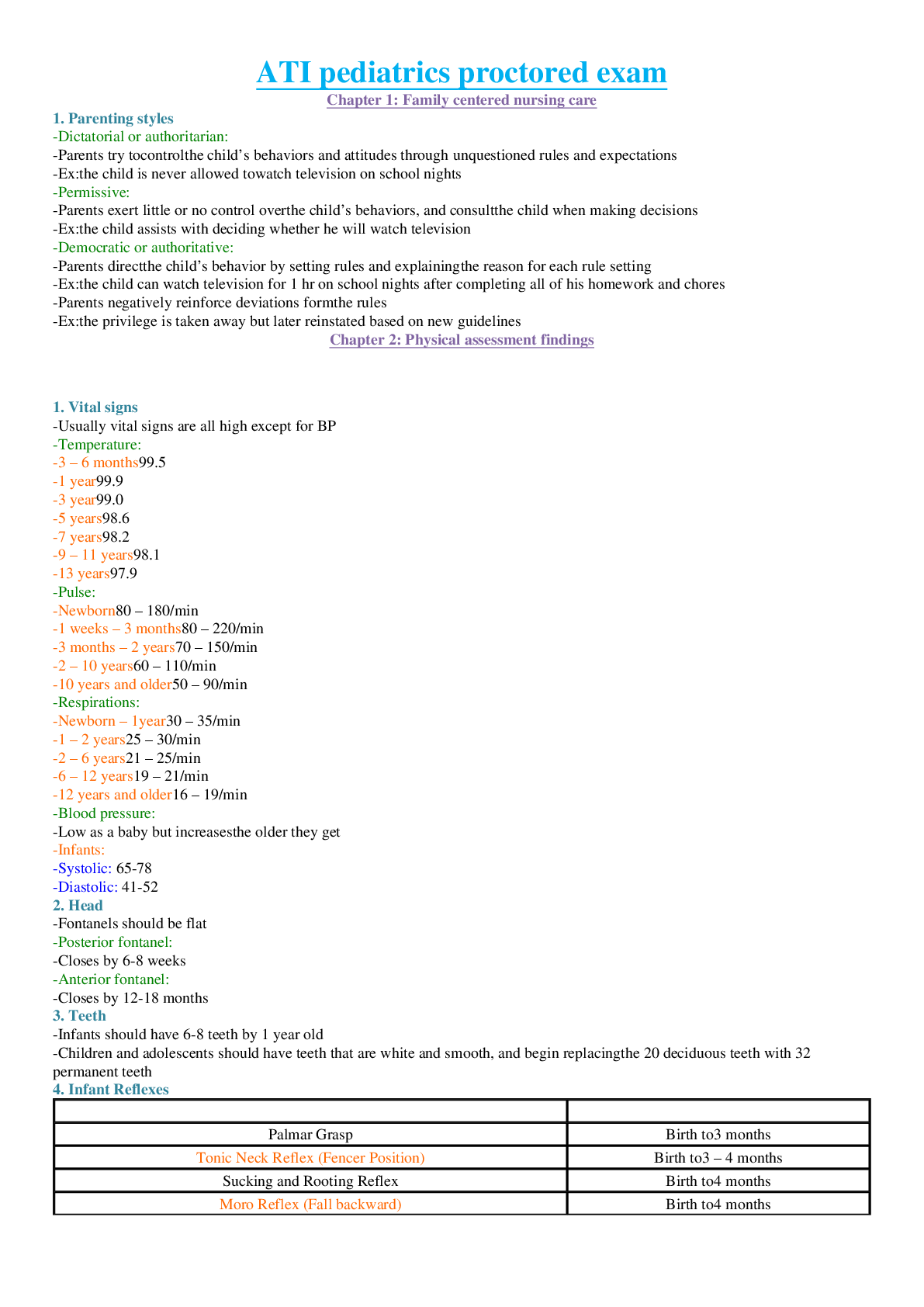*NURSING > QUESTIONS and ANSWERS > ATI NR293 antibiotic assessment quiz pharm (All)
ATI NR293 antibiotic assessment quiz pharm
Document Content and Description Below
ATI NR293 antibiotic assessment quiz pharmATI NR293 antibiotic assessment quiz pharm 1. The nurse is preparing to administer a dose of penicillin. Before administering the medication, the nurse asses... ses the patient's allergy history. Which aspect of drug therapy does this represent? A. Making PRN (as needed) decisions B. Evaluating therapeutic effects C. Ensuring proper dosage D. Identifying high-risk patients 2. Which aspect of drug therapy indicates to the nurse whether a drug is having a beneficial effect? A. Performing a pre-administration assessment B. Evaluating therapeutic responses C. Minimizing adverse effects D. Managing toxicity 3. The nurse is managing the care of a group of patients with cancer who will be receiving chemotherapy. The nurse defines goals, sets priorities, identifies interventions, and establishes criteria for evaluating success. Which phase of the nursing process does this represent? A. Assessment B. Planning C. Implementation D. Evaluation 4. Which statements about medication administration would the nurse identify as true? (Select all that apply.) A. All drugs have the potential to produce undesired effects. B. Drug therapy often can be enhanced by non-pharmacologic measures. C. Patients taking two drugs are not likely to have a drug interaction. D. Nurses' knowledge of pharmacology is more important for standing orders than for PRN medications. E. Patient adherence is essential in achieving the therapeutic objective of medications. 5. The nurse understands that the dose-response relationship is graded and should expect to observe what response? A. Once a drug is given, the response is predictably all-or-nothing. B. The response is maintained at a specific level when the therapeutic objective is achieved. C. As the dosage increases, the response becomes progressively greater. D. A graded response is based on relative potency and maximal efficacy. 6. Which drug property is most enhanced by the presence of many different types of receptors throughout the body? A. Potency B. Safety C. Selectivity D. Convenience . 7. Why does the nurse administer naloxone to a patient receiving morphine sulfate who has a respiratory rate of 8 breaths per minute? A. Naloxone causes hypersensitivity of the opioid receptors. B. Naloxone prevents the activation of opioid receptors. C. Naloxone is a partial agonist, requiring a lesser dose to achieve pain relief. D. Naloxone is an agonist, leading to desensitization of the opioid receptors. 8.The nurse reviews all of the patient's prescriptions. Which prescribed medications may cause a detrimental potentiative drug interaction? A. Aspirin and warfarin B. Sulbactam and ampicillin C. Propranolol and albuterol D. Isoniazid and rifampin 9.The nurse is concerned with minimizing adverse drug-drug interactions for the patient. Which drug characteristic could result in the most serious consequences from a drug-drug interaction? A. Low therapeutic range B. High biologic half-life C. Low potency D. First-pass effect 10. The nurse is caring for a patient who has jaundice, dark urine, malaise, light-colored stools, nausea, and vomiting. What is this patient most likely experiencing? A. An idiosyncratic drug effect on the bone marrow B. Iatrogenic disease of the kidneys C. Drug toxicity of the liver D. An allergic reaction 11. The nurse is caring for a patient prescribed Isoniazid for the treatment of tuberculosis. The nurse should assess for which signs and symptoms of drug-induced liver toxicity? (Select all that apply.) A. Nausea B. Malaise C. Jaundice D. Vomiting E. Clear urine 12. When a pregnant woman has been exposed to a known teratogen, what is the first step in identifying risks for malformation? (Select all that apply.) A. Determine exactly when the drug was taken. B. Determine exactly when the pregnancy began. C. Determine why the woman was taking the medication. D. Determine who prescribed the medication. 13. The nurse will monitor which laboratory result closely when administering medications to an older adult patient while assessing for adverse drug reactions (ADRs)? A. Serum creatinine levels B. Creatinine clearance C. Serum albumin levels D. Liver function tests 14. Older adult patients are at high risk for adverse drug reactions (ADRs). Which measures can reduce the incidence of ADRs? (Select all that apply.) A. Taking a thorough drug history, including over-the-counter (OTC) medications B. Monitoring clinical response and laboratory results to help determine proper dosage C. Using as many drugs as possible to reduce symptoms and improve outcome D. Regularly monitoring patients for drug-drug and drug-nutrient interactions E. Helping patients to avoid prescriptions for drugs on the Beers list 15. An antimicrobial medication that has selective toxicity has which characteristic? A. Ability to transfer DNA coding B. Ability to suppress bacterial resistance C. Ability to avoid injuring host cells D. Ability to act against a specific microbe 16. The development of a new infection as a result of the elimination of normal flora by an antibiotic is referred to as what? A. Resistant infection B. Superinfection C. Nosocomial infection D. Allergic reaction 17.A microbe acquires antibiotic resistance by which means? A. Development of medication resistance in the host B. Overriding of the minimum bactericidal concentration C. Incorrect dosing, which contributes to ribosome mutations D. Transfer of DNA coding to other bacteria 18. The nurse identifies which host factor as the most important when choosing an antimicrobial drug? A. Age B. Competent immune function C. Genetic heritage D. Previous medication reactions. 19. A patient has acquired an infection while in the hospital. The nurse identifies this type of infection as what? E. Superinfection F. Suprainfection G. Nosocomial infection H. Resistant infection 20. Which are examples of the improper use of antibiotic therapy? (Select all that apply.) I. Using surgical drainage as an adjunct to antibiotic therapy J. Treating a viral infection K. Basing treatment on sensitivity reports L. Treating fever in an immunodeficient patient M. Using dosing that results in a superinfection 21. A nurse is assessing the effects of antimicrobial therapy in a patient with pneumonia. The nurse should establish which outcomes when planning care? (Select all that apply.) N. Potassium level of 4 mEq/dL O. Reduction of fever P. Sterile sputum cultures Q. Oxygen saturation of 98% R. Elastic skin turgor 22. A nurse should teach a patient to observe for which side effects when taking ampicillin? A. Skin rash and loose stools B. Reddened tongue and gums C. Digit numbness and tingling D. Bruising and petechiae 23. The nurse identifies which statements about penicillin’s as true? (Select all that apply.) A. Penicillin’s are the safest antibiotics available. B. The principal adverse effect of penicillin is allergic reaction. C. A patient who is allergic to penicillin always has a cross-allergy to cephalosporins. D. A patient who is allergic to penicillin is also allergic to vancomycin, erythromycin, and clindamycin. E. Penicillins are normally eliminated rapidly by the kidneys but can accumulate to harmful levels if renal function is severely impaired. 24. A nurse observes a red streak and palpates the vein as hard and cordlike at the intravenous (IV) site of a patient receiving cefepime [Maxipime]. Which assessment should the nurse make about the IV site? A. An allergic reaction has developed to the drug solution. B. The drug has infiltrated the extravascular tissues. C. Phlebitis of the vein used for the antibiotic has developed. D. Local infection from bacterial contamination has occurred. 25. A patient who is receiving ceftriaxone has all of these medications ordered. The nurse monitors the patient for an adverse effect related to an interaction with which medication? A. Regular insulin B. Ampicillin [Polycillin] C. Naproxen [Naprosyn] D. Bisacodyl [Dulcolax] 26. Before administering a cephalosporin to a patient, it is most important for the nurse to assess the patient for an allergy history to what? A. Soy products B. Peanuts C. Penicillins D. Opioids 27. Which statements about vancomycin [Vancocin] does the nurse identify as true? (Select all that apply.) A. Vancomycin is the most widely used antibiotic in U.S. hospitals. B. Vancomycin is effective in the treatment of Clostridium difficile infection. C. Vancomycin is effective in the treatment of MRSA infections. D. Patients who are allergic to penicillin are also allergic to vancomycin. E. The major toxicity of vancomycin therapy is liver failure. 28. The nurse identifies which statements about frequent urinary tract reinfections as true? (Select all that apply.) A. Reinfections are considered frequent if the individual has three or more a year. B. Prophylactic therapy should continue for at least 2 months. C. If reinfection is associated with sexual intercourse, the risk can be reduced by instructing the patient to void after intercourse. D. Single-dose nitrofurantoin 50 mg taken 1 hour before intercourse has been found to reduce the rate of reinfection. E. If a symptomatic episode occurs, the standard therapy for acute cystitis should be used. 29. The nurse is working with a patient who has a UTI. Because patient adherence to a medication regimen is a concern, the nurse anticipates use of which medication? A. Fosfomycin B. Amoxicillin C. Cephalexin D. Trimethoprim 30. A nurse should recognize that for maximum therapeutic effects against the influenza virus, oseltamivir [Tamiflu] should be taken when? A. Two days or more after symptom onset B. When lung crackles are present C. Within 12 hours of symptom onset D. Only when fever is above 102°F 31. The nurse identifies which medication as the drug of choice for most infections caused by herpes simplex viruses and varicella-zoster virus? A. Ganciclovir B. Amantadine C. Acyclovir D. Oseltamivir [Show More]
Last updated: 1 year ago
Preview 1 out of pages

Reviews( 0 )
Document information
Connected school, study & course
About the document
Uploaded On
Apr 27, 2021
Number of pages
Written in
Additional information
This document has been written for:
Uploaded
Apr 27, 2021
Downloads
0
Views
2




